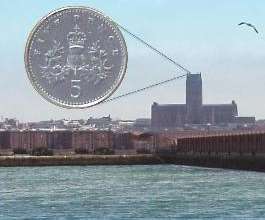Angles in Astronomy

Credit: The Schools' Observatory
Astronomers use angles a lot to work out where things are in the sky. We can measure the size of an object in the sky and mark its position by using angles. If we know how much of the sky an object covers (as an angle) and how far away it is - we can work out its actual size.
However, the angles used in astronomy are usually tiny - much less than one degree. So, astronomers have broken down degrees into much smaller chunks. We often use measurements called arcminutes and arcseconds. The way we define each of these measurements is:
- there are 360 degrees in a circle.
- an arcminute is 1/60th of a degree.
- an arcsecond is 1/60th of an arcminute.
So that means there are 1,296,000 arcseconds in a circle (360 degrees × 60 arcminutes × 60 arcseconds).
It's hard to try and picture this. It means that a five-pence coin would measure 1 arcsecond across if you placed it 3 kilometres away! (This is the distance to Liverpool Cathedral in the picture).

